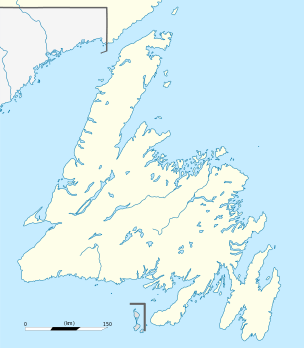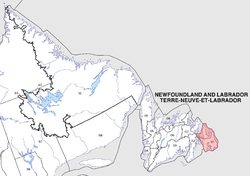Bay Bulls, Newfoundland and Labrador
| Bay Bulls | |
|---|---|
| Town | |
|
Bay Bulls in August, 2006 | |
 Bay Bulls Location of Bay Bulls in Newfoundland | |
| Coordinates: 47°18′57″N 52°48′37″W / 47.31583°N 52.81028°W | |
| Country |
|
| Province |
|
| Settled | 1592 |
| Area | |
| • Total | 30.74 km2 (11.87 sq mi) |
| Population (2006) | |
| • Total | 1,078 |
| Time zone | Newfoundland Time (UTC-3:30) |
| • Summer (DST) | Newfoundland Daylight (UTC-2:30) |
| Area code(s) | 709 |
Bay Bulls (2006 population 1,078) is a small fishing community in the province of Newfoundland and Labrador, Canada.
Geography
Located in sheltered bay it has been home to many fishermen and a strategic location in early times as it is located just a few miles from the capital, St. John's.
History
Bay Bulls first appears on a 1592 map drawn by Thomas Hood. The exact origin of the name is a mystery, however; Bishop Howley believed it was originally named Bay Boulle by Jersey fishermen. Some other variations conjectured that it comes from the common Dovekie Bull-Bird which can be found in the area.

Fortification of the harbour came in 1638 by Governor David Kirke. In 1655, Bay Bulls was raided by Dutch sailors under Admiral De Ruyter. During King William's War, the village was attacked twice. In 1696, Monbeton de St. Ovide de Brouillan, the governor of Placentia, attacked Bay Bulls from the sea, sinking the English warship HMS Sapphire. Then in 1697 Pierre Le Moyne d'Iberville marched overland from Placentia and attacked Bay Bulls in the Avalon Peninsula Campaign. In 1702, Rear Admiral John Leake of the Royal Navy entered Bay Bulls with several Men of War, and received information about the whereabouts of French ships and unprotected settlements around the Avalon Peninsula, which he then attacked. On June 24, 1762 the French led by Admiral d'Arsac de Ternay, landed seven hundred men who occupied Bay Bulls and marched to St. John's. Bay Bulls suffered its last invasion on September 29, 1796 when Admiral Richery attempted to storm St. John's but finding it well defended; he attacked and burned Bay Bulls instead.
In 1890 the Roman Catholic Church, St. Peter and St. Paul was rebuilt. The gate was initially marked by cannons left over from the battles with the French, then statues of the Saints were added on top, which gave the famous "Cannonized Saints of Bay Bulls."
Economy
Bay Bulls is a fishing community and was established because of its closeness to the rich fishing grounds on the Grand Banks. Due to its proximity to St. John's the population is becoming more of a bedroom community for people employed there. Bay Bulls has been at the forefront of many strategies such as fish farming and lately servicing the Oil and Gas industry. The Penney Group of Companies has built a repair facility that services the many oil rigs that drill for oil on the Grand Banks. Tourism has become an important part of the community as well. Four whale and bird watching establishments, as well as several bed-and-breakfast places attract visitors from all over the world.
Demographics

| Population in 2011 | 1,283 |
| Population change from 2006 | 19.0% |
| Median age (2011) | 38.7 |
| Total number of dwellings (2011) | 545 |
| Land area (km².) | 30.74 |
| Population Density (per km²) (2011) | 41.7 |
| Source - Statistics Canada[1] | |
See also
References
- ↑ "Census Profile - Bay Bulls". Statistics Canada. Retrieved 19 December 2012.
External links
Coordinates: 47°18′57″N 52°48′37″W / 47.31583°N 52.81028°W
